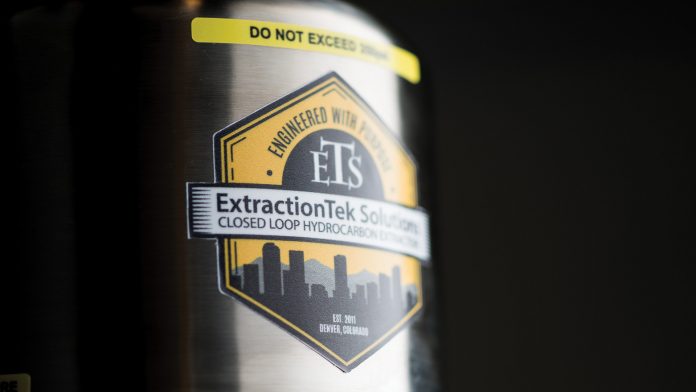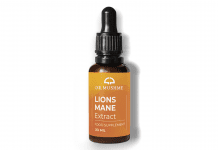
Organic hydrocarbon solvents offer key benefits in cannabis extraction for patients, manufacturers and policymakers alike.
Organic solvent-based extraction is very common throughout the chemical, food, personal care, pharmaceutical and perfumery industries as well as many others. The modern cannabis industry has essentially repurposed current methodologies from these previous industries. Cannabis extraction using organic solvents is easily comparable to the making of absolutes for the personal care and perfumery industries. An absolute is a concentrated, highly aromatic oil extracted from plants.
‘First, an organic solvent, such as hexane, is added to the plant material to help extract the non-polar compounds. This solution is filtered and concentrated by distillation to produce a waxy mass called concrete. The more polar, fragrant compounds are extracted from the concrete into ethanol. When the ethanol evaporates, an oil – the absolute – is left behind.’1
The process explained above involves the use of two consecutive extractions using two different organic solvents. This process or a similar process is used to make vanilla concentrate, rose oil, jasmine concentrate, mimosa concentrate, beeswax, and several other natural derivatives we enjoy in our daily life. This same process is currently being used to manufacture cannabis concentrates.
Why hydrocarbons?
Currently, the most popular solvents for cannabis extractions are butane and propane, although CO2, ethanol, and heat and pressure are also employed. These hydrocarbon solvents are chosen over other organic solvents because they are superior for the purpose of economically producing high-quality extracts at an accelerated rate, safely.
These are being produced using quality organic solvents that test to instrument grade specifications. Less processing time at a lower cost creates a higher supply of a quality product. This in turn drives down the price per unit once the demand is met and results in increased ‘reasonable access’ for patients. It’s important to note that the same quality, price point, or purity of extracts produced from organic solvent extraction cannot be re-produced using CO2 extraction or any other non-organic solvent-based extraction method.
Consequently, there is a possibility that not allowing these types of products in a legal market will cause a demand for these same products in the black market, at a higher price. Black market hydrocarbon extraction is usually done using a technique called open-blasting which is an extreme hazard to the environment due to its high volume of waste from not using a closed-loop system and is an extreme safety hazard likely to cause fires and explosions. Allowing patients to buy these end products in a store at a low price would deter them from making them at home and potentially endangering themselves, the environment and their neighbours.
Local safety concerns
The use of organic solvents for cannabis extraction is being debated due to the safety of the manufacturing process, the end consumer and the environment. Organic solvents as defined by the law are ‘any organic compound that is explosive or highly or extremely flammable, including petroleum naphtha and compressed liquid hydrocarbons such as butane, isobutane, propane and propylene’.2
Superficially, the purpose of this section is to avoid accidents resulting in fires that may endanger the lives of manufacturing operators, the business and the neighbours. To ensure local safety, manufacturers usually take every precaution available as is required by the Authority Having Jurisdiction (AHJ). These precautions can be explained as a two-pronged approach to eliminate the possibility of fire or explosions.
The first prong is making the entire extraction space a Class 1 Division 1 (C1D1) room. The classification of C1D1 room is defined by the National Fire Protection Association, as stated in NFPA 58, Liquefied Petroleum Gas Code. NFPA codes, standards, recommended practices and guides are developed through a consensus standards development process approved by the American National Standards Institute.
A C1D1 space ensures all the air in the room is constantly being replaced and the entire space (including HVAC and electrical) is completely spark-free. In addition to these protections there is a solvent detector that turns on the emergency HVAC system when the detector senses the solvent level in the room approaches 25% of the lower flammability limit (LFL). The LFL is the absolute lowest amount of solvent that needs to exist in air with an ignition source to cause a flame.
The second prong of this two-pronged approach is employing a trained operator to work on a certified, peer-reviewed and closed-loop extractor. Equipment is built specifically for this purpose, engineered to operate in a C1D1 environment with the highest safety standards.
In established markets the equipment and environment are regularly serviced and inspected for compliance by the AHJ and certifying engineer. As a result of all these protections solvent extraction is extremely safe and there have been no reported major injuries, incidences of fires or explosions in a regulated cannabis extraction facility to date.
Health safety concerns
Naturally, there is concern that the operator will be over-exposed to solvent, causing health complications, or the end consumer may ingest product containing residual solvent that may harm them. As an extraction environment requirement, it is necessary to constantly replace the air in the C1D1 room, spontaneously replace all the air in the event the detector reads 25% of the LFL, and use peer-reviewed equipment by a trained operator.
‘The 10-min Acute Exposure Guideline Limit (AEGL-1, non-disabling) value is 10,000ppm (24,000mg/m3), which is greater than 50% of the lower explosive limit for butane in air of 19,000ppm. Therefore, extreme safety considerations against the hazard of explosion must be taken into account.’3
Likewise, a similar response is given for propane: ‘The AEGL-1 (non-disabling) value is greater than 10% of the lower explosive limit for propane in air of 23,000ppm. Therefore, safety considerations against the hazard of explosion must be taken into account.’4
The AEGL value is the value at which a human can start to feel the effects of exposure to solvent; at AEGL-1 (19,000pm over ten minutes) this effect is drowsiness, at AEGL-2 (24,000ppm over ten minutes) this effect is disabling, and at AEGL-3 (77,000ppm over ten minutes) this effect is lethal.
Due to the fire and explosion protections in place the operator is extremely unlikely to feel the effect of exposure to solvent even in the worst-case scenario because he will never be exposed to even half this amount in any given instance over any period of time.
This same concept explained above extends to the patient’s safety. The safety of the solvents used for cannabis extraction need to be re-evaluated from a scientific and health perspective in order to determine if residual solvents in products are detrimental to our health. The best-case study for this is from the oldest regulated cannabis market in the US.
Colorado changed their residual solvent content in cannabis extracts to be consistent with the pharma industry.
“The proposed limits are consistent with those adopted by [the] international organisation5 for residual solvents in pharmaceuticals and by the Association of Public Health Laboratories6 for residual solvents in cannabis extracts. These proposed health-based limits (except benzene) are based on the toxicity of individual solvents and the magnitude of exposure expected to occur from consuming ten grams.’7
In short, the regulation adjusted the maximum residual solvent content in cannabis extracts to be consistent with other industries, which raised the limit from <800ppm of butane to <5,000ppm of butane and from <500ppm of propane to <5,000ppm of propane. This massive increase was a conclusion ‘to reflect conservative health-based criteria’7 drawn from scientific data collected and/or analysed by the International Conference on Harmonization of Technical Requirements for Registration of Pharmaceuticals for Human Use and the Association of Public Health Laboratories.
This conclusion makes sense given that a person must be exposed to 10,000ppm over the duration of ten minutes to reach AEGL-1, and the act of smoking or using a product derived from concentrate cannot come remotely close to ingesting the amount of solvent needed to cause drowsiness or any other adverse effect. On the manufacturer’s side, in practice, the actual likelihood of producing a product with a residual solvent level of 5,000ppm is very unlikely due to the boiling point of butane being -1ºC and propane being -42ºC, and the post-processing steps require the use of low heat under vacuum, which lowers these boiling points much further.
Necessary for research
Allowing cannabis manufacturers to use solvent for processing, like all other related industries, has greater benefits that extend past providing safe ‘reasonable access’ to patients. Allowing solvents also paves the way for the development of knowledge for the entire industry. To make greater purity products or isolates for better product formulations and research purposes, solvents are absolutely necessary.
THCA (non-psychoactive) is a very valuable cannabinoid that readily degrades to THC (psychoactive) under pressure, vacuum and/or heat. The same is true for CBDA, THCVA, CBDVA, CBGA, CBCA, etc. Due to the restriction on research many of these compounds have had only the most minimal amount of research done on them to determine they do have great potential.
We’ve also determined there are many more molecules in the plant from diverse genetics that are yet to be discovered. As a research community we need to accumulate more data. Not allowing the use of solvents would create a large opportunity loss of valuable research from manufacturers or the supply of research materials that can benefit others.
Conclusion
Governments worldwide should allow the use of organic hydrocarbon solvents for the use of cannabis manufacturing. Under the regulation of the government the benefits will increase ‘reasonable access’ for patients, create higher quality and a greater diversity of products for patients, give manufacturers the ability to develop cannabis research, and eliminate a potential black market along with the dangers associated with unregulated and often dangerous cannabis extraction.
References
- Karl-Georg Fahlbusch et al. (2007) Flavors and Fragrances, Ullmann’s Encyclopedia of Industrial Chemistry (7th ed.), Wiley, p83
- Proposed Bill C-45, Part 1, Division 1, Section 12(3)
- Committee on Acute Exposure Guideline Levels; Committee on Toxicology; Board on Environmental Studies and Toxicology; Division on Earth and Life Studies; National Research Council. Acute Exposure Guideline Levels for Selected Airborne Chemicals: Volume 12. Washington (DC): National Academies
Press (US); 2012 Apr 27. 1, Butane: Acute Exposure Guideline Levels. Available from: https://www.ncbi.nlm.nih.gov/books/NBK201460/ - Committee on Acute Exposure Guideline Levels; Committee on Toxicology; Board on Environmental Studies and Toxicology; Division on Earth and Life Studies; National Research Council. Acute Exposure Guideline Levels for Selected Airborne Chemicals:
Volume 12. Washington (DC): National Academies
Press (US); 2012 Apr 27. 7, Propane: Acute Exposure Guideline Levels. Available from: https://www.ncbi.nlm.nih.gov/books/NBK201461/ - International Conference on Harmonization of Technical Requirements for Registration of Pharmaceuticals for Human Use, ICH Harmonized Tripartite Guideline, Impurities: Guideline for Residual Solvents Q3C (R5) (ICH Q3C), www.ich.org/fileadmin/Public_Web_Site/ICH_Prod
ucts/Guidelines/Quality/Q3C/Step4/Q3C_R5_Step4.pdf - Association of Public Health Laboratories, Guidance for State Medicinal Cannabis Testing Programs, May 2016, http://www.aphl.org/aboutAPHL/publications/Documents/EH-Guide-State-Med-Cannabis-052016.pdf
- Dyke, Myke Van. Colorado Residual Solvent Rule Change Letter. Scribd, Colorado Department of Public Health and Environment, 15 June 2016, www.scribd.com/document/334002261/Colorado-Residual-Solvent-Rule-Change-Letter
Sean Winfield
Chief Marketing Officer
ExtractionTek Solutions
Philip Kwong
CEO
3 Carbon
+1 720 306 9164
+1 778 751 8765
Sean@ExtractionTek.com
https://extractiontek.com/
Please note, this article will appear in issue 9 of Health Europa Quarterly, which is available to read now.







